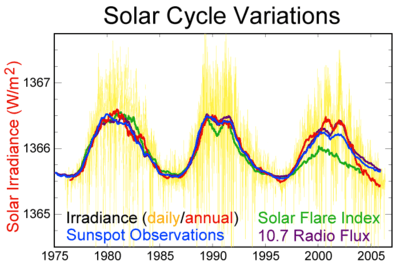Solar cycle 13
| Solar cycle 13 | |
|---|---|
 The solar corona during an eclipse in solar cycle 13 (1893). | |
| Sunspot Data | |
| Start date | March 1890 |
| End date | February 1902 |
| Duration (years) | 11.9 |
| Max count | 87.9 |
| Max count month | January 1894 |
| Min count | 2.7 |
| Spotless days | 936 |
| Cycle chronology | |
| Previous cycle | Solar cycle 12 (1878-1890) |
| Next cycle | Solar cycle 14 (1902-1913) |

Solar prominences during an eclipse in solar cycle 13 (28 May 1900).
Solar cycle 13 was the thirteenth solar cycle since 1755, when extensive recording of solar sunspot activity began.[1][2] The solar cycle lasted 11.9 years, beginning in March 1890 and ending in February 1902. The maximum smoothed sunspot number (monthly number of sunspots averaged over a twelve-month period) observed during the solar cycle was 87.9 (January 1894), and the minimum was 2.7.[3] There were a total of approximately 938 days with no sunspots during this cycle.[4][5][6]
There were a number of intense solar proton events during solar cycle 13.[7] For example, a geomagnetic storm in September 1898 affected telegraph lines.[8]
See also
References
- ↑ Kane, R.P. (2002). "Some Implications Using the Group Sunspot Number Reconstruction". Solar Physics 205(2), 383-401.
- ↑ "The Sun: Did You Say the Sun Has Spots?". Space Today Online. Retrieved 12 August 2010.
- ↑ SIDC Monthly Smoothed Sunspot Number. ""
- ↑ Spotless Days. ""
- ↑ What's Wrong with the Sun? (Nothing) more information: Spotless Days. ""
- ↑ Solaemon's Spotless Days Page. ""
- ↑ Peristykh, A. N.; Damon, P. E. (17–25 August 1999). Multiple Evidence of Intense Solar Proton Events During Solar Cycle 13. Proceedings of the 26th International Cosmic Ray Conference. pp. 264–267.
- ↑ http://www.solarstorms.org/SRefStorms.html
This article is issued from Wikipedia - version of the 11/4/2016. The text is available under the Creative Commons Attribution/Share Alike but additional terms may apply for the media files.
